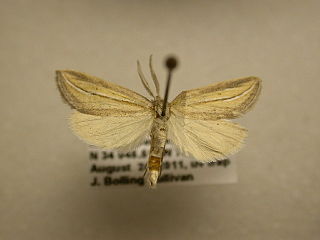
Doryodes is a genus of moths in the family Erebidae.

Graphiphora augur, the double dart or soothsayer, is a moth of the family Noctuidae. The species was first described by Johan Christian Fabricius in 1775. It is found in all of Canada and most of the northern parts of the United States, south in the west to California and New Mexico. It is also found throughout Eurasia, from the British Isles and Scandinavia to Siberia and Japan.
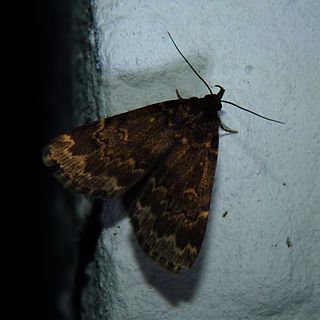
Idia lubricalis, the glossy black idia, is a litter moth of the family Erebidae. The species was first described by Carl Geyer in 1832. It is found from Canada south to Florida and Texas in deciduous forests.
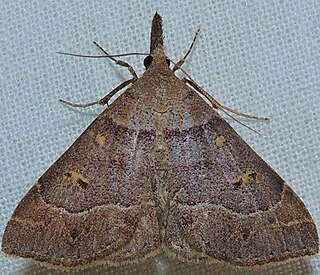
Renia flavipunctalis, the yellow-dotted renia, yellow-spotted renia or even-lined renia, is a litter moth of the family Erebidae. The species was first described by Carl Geyer in 1832. It is found from southern Canada to Florida and Texas.

Scolecocampa liburna, the dead-wood borer, is a moth in the family Erebidae. The species was first described by Carl Geyer in 1837. It is found in the US from southern Wisconsin and Michigan to central New England south to Florida and Texas.

Hypoprepia miniata, the scarlet-winged lichen moth or scarlet lichen moth, is a moth of the family Erebidae. The species was first described by William Kirby in 1837. It is found from British Columbia south through the western side of the Rocky Mountains to Arizona and Texas. It is also found throughout eastern North America.

Virbia laeta, the joyful holomelina, is a moth in the family Erebidae. It was described by Félix Édouard Guérin-Méneville in 1844. It is found in North America from New Brunswick south to Florida and west to Minnesota and south to Texas. The habitat consists of pine woodlands.
Conchylodes diphteralis is a moth in the family Crambidae. It was described by Carl Geyer in 1832. It is found from the southeastern United States, where it has been recorded from Florida, through the West Indies to South America.

Arugisa lutea, the common arugisa moth, is a species of moth in the family Erebidae. The species was first described by John B. Smith in 1900. It is found in the United States, where it has been recorded from Maryland and Virginia to Florida, west to Texas and Missouri.

Doryodes insularia is a moth of the family Erebidae first described by George Hampson in 1904. It is found on the Bahamas.

Doryodes spadaria, the dull doryodes moth, is a moth of the family Erebidae. The species was first described by Achille Guenée in 1857. It is found in North America, where it has been recorded from coastal Florida, Georgia, North Carolina, South Carolina and Texas. The habitat consists of salt marshes.

Doryodes tenuistriga is a moth of the family Erebidae first described by William Barnes and James Halliday McDunnough in 1918. It is found in North America, where it has been recorded from costal Texas and Louisiana.
Boryzops purissima is a species of moth of the family Erebidae. It is found in the southern United States, where it has been recorded from Florida and Texas, as well as in Veracruz in Mexico, Costa Rica and Jamaica.
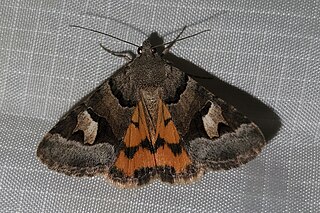
Drasteria stretchii is a species of moth in the family Erebidae. It is found in North America, where it has been recorded from northern Nevada., California, Oregon, Wyoming and Washington. The habitat consists of dry, rocky canyons at low to middle elevations.

Doryodes desoto is a moth of the family Erebidae first described by J. Donald Lafontaine and James Bolling Sullivan in 2015. It is found along the Gulf Coast of the US state of Florida between Sarasota County and Gulf County. The habitat consists of coastal salt marshes.

Doryodes okaloosa is a moth of the family Erebidae first described by J. Donald Lafontaine and James Bolling Sullivan in 2015. It is found in the US in Okaloosa County, Florida and likely ranges south in the coastal brackish marshes toward the St. Petersburg/Tampa area and to the west along the Florida coast.
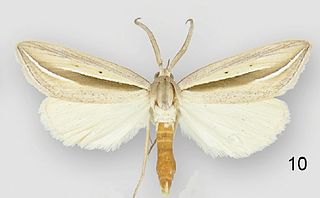
Doryodes fusselli is a moth of the family Erebidae first described by J. Donald Lafontaine and James Bolling Sullivan in 2015. It is found in the US state of North Carolina, occurring from Dare County in the north to Brunswick and New Hanover counties in the south.

Doryodes latistriga is a moth of the family Erebidae first described by J. Donald Lafontaine and James Bolling Sullivan in 2015. It is found in the United States in tidal creeks and salt marshes from Alabama to Louisiana.

Doryodes broui is a moth of the family Erebidae first described by J. Donald Lafontaine and James Bolling Sullivan in 2015. It is found in the United States from Alabama to southern Texas.

Doryodes reineckei is a moth of the family Erebidae first described by J. Donald Lafontaine and James Bolling Sullivan in 2015. It is found along the US Gulf Coast in the western panhandle of Florida along to eastern Texas. The habitat consists of Spartina marshes.



















